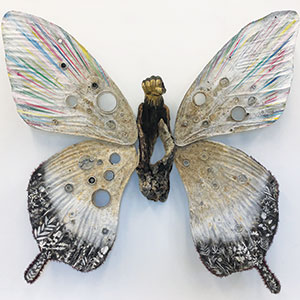
Severed at the neck, a giant’s head hangs from the ceiling in mid-air. His eyes are closed; his lips slightly parted. This is the white plaster face of a god in repose. He might be contemplating his next act of creation.
His expression is as enigmatic as the iconic stones on Easter Island. Long scraps of bark coat his neck, creeping toward the edges of his forehead, cheeks and chin. A green man made out of wood and the elemental earth. Hector Dionicio Mendoza’s Head/Cabeza is one of several sculptures in his solo show, “White Wilderness/Maleza Blanca” (at the Triton Museum of Art through Nov. 3) that makes contact with the divine. But the gods and demigods who populate the gallery aren’t merely benevolent or blandly beatific.
Acting as a sentinel and a figurehead at the exhibit’s entrance, White Wilderness is a hybrid piece, a sculpture that spills into and shares psychic real estate with a misshapen canvas. The bust of a man’s head is inked in black and white. Leafy patterns from a jungle or forest cover every inch of his neck, facial features and smooth, bald scalp. Both his eyes and his lips open up to reveal an admonitory blackness. The pattern on his skin drifts east and drips south until a distorted second face emerges. As this shadow self stretches away from the bust, a process of dislocation and disorderliness ensues. This is the portrait of a soul in disarray.
Mendoza was born in Uruapan, Michoacan, México in 1969 and moved to California with his family when he was 12 years old. During a month-long artist’s residency at the Monterey Museum of Art in 2018, he described his work as “a social statement, a commentary on society.” This sounds dry on paper but is visionary in practice. In Pulling/Jalando, Mendoza sculpts a man whose head has become such a burden that it drags down behind him on the ground. The figure’s stancefeet firmly planted against an opposing forceis that of someone in a tug-of-war with his own psyche. His fragile, elastic neck is elongated to such an extent that it might just snap off. The head, if that’s what it is, looks like a cement narwhal that’s been stripped of its magic pallor, tail, horn and fins. But Mendoza also creates a porthole with a glassy kaleidoscopic interior to indicate a brain that’s turning in intricate, fully functional and beautifully moving circles.
Where Pulling/Jalando exerts a strange, abstract influence on the viewer, other sculptures convey more direct messages. The artist references Hercules in the title of one piece but Holding/Leaning/Pushing and Silhouette/Silhueta 01 summon up the burdens of Atlas and Sisyphus. Mendoza’s work in “White Wilderness/Maleza Blanca” is towering in scale, but they’re not simply heavy objects that take up space or to stare at in awe; they bear a meaningful, psychological weight. Holding and Silhouette use different materials that show two men with their hands held up in the air. Their backs are to us. These are the postures of people who are being detained or arrested. Mendoza covers the hands and legs of the figure in Holding with bark but emphasizes the vulnerability of the flesh by leaving the arms, back and buttocks gray and bare.
The sculpture that takes the most conventional approach to realpolitik is Mariposa/Butterfly. Donna Conwell, an associate curator at the Montalvo Arts Center, writes that Mendoza’s work “is created by carefully collecting, drying and pressing various species of flora samples between pages of heavy books.” This is how he created the “tattoo” effect on White Wilderness and the lower edges of his butterfly’s wings. He paints the two upper wings with thin lines of bright colors, but this prehistoric-size insect doesn’t seem poised for flight. In place of a thorax, the artist connects the wingspan with a hollowed-out wedge of driftwood. He replaces the antennae with a fist that he’s painted gold. It’s the only unambiguous message in a hall full of dreamed-up monsters who alarm the senses and align our collective political consciousness with the uncanny.
White Wilderness/Maleza Blanca
Thru Nov 3, Free
Triton Museum of Art, Santa Clara
tritonmuseum.org


